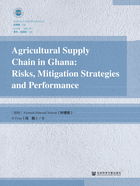
1.3 State of the Art
1.3.1 Major Agricultural Supply Chain Risks
Previous research has shown that global agricultural supply chain could operate in an unstable environment and faces several sources of risks. Among these risks identified in supply chain include extreme weather related risk. According to Helferich and Cook[20],weather related risks such as tsunamis,drought,hurricanes,floods are a constant threat to societies in general and to firms in particular. Biological and environment related risks are of great importance in the agricultural supply chain. In their research,Baltussen,et al.[21] as well as Palinskas and Szekely[22] revealed biological and environmental related risks such as diseases are a major concern among livestock and crops producers. In addition,according to earlier research Dutch farmers view diseases among the top risks in their operations. The market related risk is a canker in supply chain management[23][24]. Supply chain market related risks have been pinned to the uncertainty of demand and supply in the chain. According to Agrell,et al.[25] market related risk such as demand volatility is still the major problem discussed in the literature[26][27][28][29][30]. Jüttner[31] attributed changes in supply and demand among others as the causes of market related risk in agricultural supply chains. Others supply chain related risk that could affect agricultural supply chains are logistics and technology related risks. Past research studies attribute delays at ports,change of transportation cost,among others as political related risks[32][33][34][35][36],policy and institutional (regulatory,legal and bureaucratic) related risks[37][38][39][40][41][42][43] and managerial and operational related risks[44].
1.3.2 Risk Management
Risks could have a detrimental effect on agricultural supply chains. Earlier research shows that,unstable environments increase the prevalence of disruptions to firms supply chain that yields negative consequences to firms[45][46][47][48][49]. According to Ellegaard[50],understanding risk in the supply chain will be the best to accommodate these components:(1) the knowledge of a risk event;(2) the probability of occurrence of a risk event;(3) the impact of a risk event and (4) risk mitigation.
Earlier research indicates that,when choosing the most relevant risks,it is important to know the consequences that the risks bring to the business[51][52][53][54].
Past research reveals numerous benefits and importance of performance measurements to firm supply chains[55][56][57][58][59][60][61][62][63]. However,according to A. Beamon[64],there are difficulties in performance measurements and their classification of firms. Supply chain performance measures have been associated with total cost,customer responsiveness and flexibility[65][66]. In the agricultural supply chain,are found significant relationships between agricultural supply chain performance and a set of variables (cost,suppliers,flexibility,customers,time and process). Aramyan,et al.[67] pointed the importance of food quality and safety to propose and test as a performance measure in agricultural supply chains.
Numerous research in the past investigated the relationship between supply chain risks and performance[68][69][70][71][72]. The results of most of the earlier research revealed a significant impact of risks on supply chain performance. Other earlier research has proposed numerous risk mitigation strategies such as flexibility[73][74][75],supplier development[76][77].